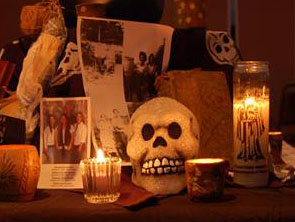
Mother Grove Goddess Temple
In a sentence…I love my pagan temple because it’s loving, open-hearted, and as full of wonderful ritual as any church I’ve ever attended. This week, I attended an ancestor vigil grounded in the pagan tradition of Samhain. Samhain is one of the biggies in the pagan tradition – the start of the New Year and the time when the veil between this world and the otherworld has thinned. If you consider yourself a follower of an earth-based tradition, you don’t miss Samhain. That would be like a Christian missing the candlelight Christmas Eve service.
Our pagan temple, officially called Mother Grove Goddess Temple, holds its Samhain celebration in the parish hall of our local, progressive Episcopal church. The fact that the Episcopal Cathedral sometimes shares its space with our local congregation dedicated to the Divine Feminine is just another reason to love Asheville, NC. I’ve been to several services honoring the pagan Wheel of the Year festivals, but my favorite ones are those held at night, like Samhain. This year, we entered the hall and took a seat in one of the chairs placed around the outside wall of the room. There was a beautiful altar in the center, filled with lit candles, a small cauldron of water, slips of paper with writing on them held in place with a small stone, and various mementos of people who had died. We were invited to place our own mementos on the altar, which I did. In the last few weeks, two people I knew died, at a relatively young age, of massive heart attacks. I wrote their names on a small red heart, placed it on the altar, and took a seat in one of the chairs.
Good ritual continues to amaze me. It provides both a sense of connectedness to others and of groundedness deep within ourselves. It reminds us that there is something bigger, deeper, and more mysterious than what goes on in our daily lives. And it allows us to be fully present in the moment. The Samhain celebration did not disappoint. We sang a song and then folks were asked to rise and name loved ones who had recently died. I was stunned at the poignancy of this. Asheville is a relatively small town, and I recognized the names a few people named. In most cases, however, I had no idea who these people were. I didn’t know the people releasing the name, and I didn’t know the dead person named. Yet I, like many others in the room, was moved to tears.
A vocalist offered a bone-jarring solo. A short talk about the tradition of Samhain and the importance of honoring ancestors followed. We were then invited to do two things. First, we could approach the altar and take one of the slips of paper with writing on it. The writing contained the name of someone – usually a woman – killed for being a witch. It contained the name of the person, how they were killed, and a date and location of the death. Some died long ago. Others were more recent. Participants read the name aloud and then placed the small stone into the cauldron of water. The rest of us held the memory. Second, we were invited to approach a smaller altar at the back of the room to light a candle for the dead we wished to honor. We closed by sharing a hug around the circle. And then, with a deep breath, we moved back into the cool night air, feeling just a bit refreshed, a bit rejuvenated, and a bit renewed.
Good ritual helps us recognize something new about ourselves and our lives. It opens a new door and gives us a little nudge. It lingers. This year, during the ancestor vigil, I realized how difficult it is at times to remember exactly when people die. My Papa died at some point when I was in middle school. My Nana died at some point during my college years. I couldn’t even remember precisely who had died within the last year. So, this year, I am planning to keep a “Samhain list,” as our local witch calls it. I already have my piece of paper on my home altar. Instead of being a once-a-year Samhain-er, I’ll try to carry this Samhain message with me every day. And that’s the real sign of good ritual.